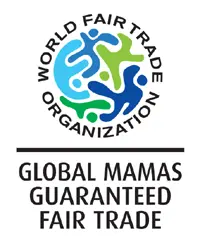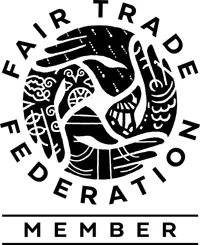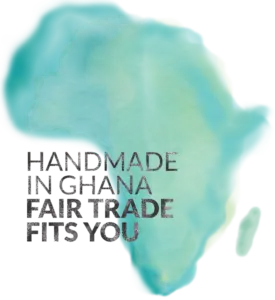After a decade of fundraising, and with the help of generous donations from our support network, we were finally able to complete our first buildings at the Fair Trade Zone (FTZ) at the end of 2021. Last month, we officially made the FTZ our new home! The FTZ houses production spaces for batikers, weavers, papermakers, seamstresses, and bead assemblers. There are also spaces for quality control, administrative offices, and a large open-air area for meetings, lunch breaks, and yoga. Though we have endless people to thank throughout our global village for making our dream become a reality, we especially want to recognize the efforts of the following people for the innovative design and execution of the project: Juergen Strohmayer (Architect), Chrili Car (Landscape Architect), German Engineers Without Borders (Engineers), Abdul-Rauf Issahaque (Design Assistant), Lawrence Mensah from ALConstructs (Building Contractor), and Mae-ling Lokko and Sophie Morley (Relentless Mentors).
Upon our big move of two of our nearby offices to the FTZ, a three-day orientation was held to officially welcome everyone to the FTZ and give them an overview of the features of our new eco-friendly facility, like the biogas digester, urine-diverting toilets, bamboo pillars, compressed earth blocks, and earth-rendered walls. We also covered the history of Global Mamas, had team-building activities, and declared our commitment to being Eco-Mamas. Eco-Mamas are those who have pledged to reduce, reuse and recycle so that they can play their part in protecting the environment. The Akuse Mamas and the Krobo Mamas have now unified into the FTZ Mamas. They’ve been adding their personal touches to the space to really make it home and we figured it’s about time for a tour of the FTZ!



So welcome to the FTZ – follow us inside for a quick tour.
Bead Inventory & Packing Room
This is the inventory room where all the beads we use in our production processes are kept. After receiving the beads from the bead makers in Krobo they are taken to quality control where the beads are sorted according to size, color, and type. We’ve got over a hundred different beads, all of which are made from recycled glass. Next to the bead inventory room is the packing room. After finished items are approved by quality control, they are sent to the packing room to be stored and prepared for shipment. On some days, you’ll find the production manager printing out orders for products to be sewn, configuring the items into our custom production database, and packing products for export.

Administrative Office, Sewing, and Beading Rooms
A few steps away from the packing room is the administrative office, where our production managers, HR, marketing, and bookkeepers spend their day. The office is equipped with large windows on all walls to make sure the room stays well-ventilated during the hot afternoons. The sewing and beading rooms provide excellent lighting so the Mamas don’t have to strain their eyes when cutting, sewing, or assembling beaded products. The layout of these rooms was developed in collaboration with the Mamas using a participatory design methodology. As the name implies, they were active participants in the design of the layout.

Quality Control and Textile Inventory Room
When the batikers finish hand printing their designs, the fabric is brought here to our quality control (QC) team to check for any imperfections. Afterwards, the batiked fabric is whisked away into the inventory room where it’s sorted into different categories. The inventory room houses all the materials used when sewing our products. When the inventory manager receives an order, she releases the exact materials needed by the seamstresses. Like all the other rooms at the FTZ, the QC and Textile inventory rooms are made with compressed earth blocks to help keep the rooms cooler, and full-length windows that provide ample natural light and ventilation. This provides the Mamas with excellent lighting to inspect and sort the products.


Batiking and Papermaking
Next up, our batiking workspace. This area is divided into three main sections, where batiking, dyeing, and dewaxing are carried out. Both sides of the batiking area are equipped with shelves to store the stamps and the dyes used in batiking. A few steps away from the batiking area, are the drying lines where the beautiful fabrics are hung to dry after dyeing or dewaxing. The workspace is in the open air with bamboo pillars on either side to give the batikers shade and cool their space.



Adjacent to the batiking section is the papermaking workspace. Also using a similar open-air plan, the workspace is more fluid because the Mamas can move around. The papermaking drums and machines occupy the left side of the space. This is where the production of our hyacinth paper happens. On the right side of the space is our hyacinth weaving section, where the hyacinth raw materials for our trivets and coasters are made. The papermaking workspace is also equipped with storage space where they can store paper, tools, and safety gear.


Our final stop is outside to visit the loom weavers who are working on weaving water hyacinth and fabric together for our table runners and new water hyacinth bags and wallets. We’re excited to showcase our new line of eco-friendly accessories.

With that, our brief tour of the Fair Trade Zone comes to an end…for now! We cannot begin to thank all of you, who have supported us through this decade-long journey. We are so proud to finally be at home at the Fair Trade Zone.





